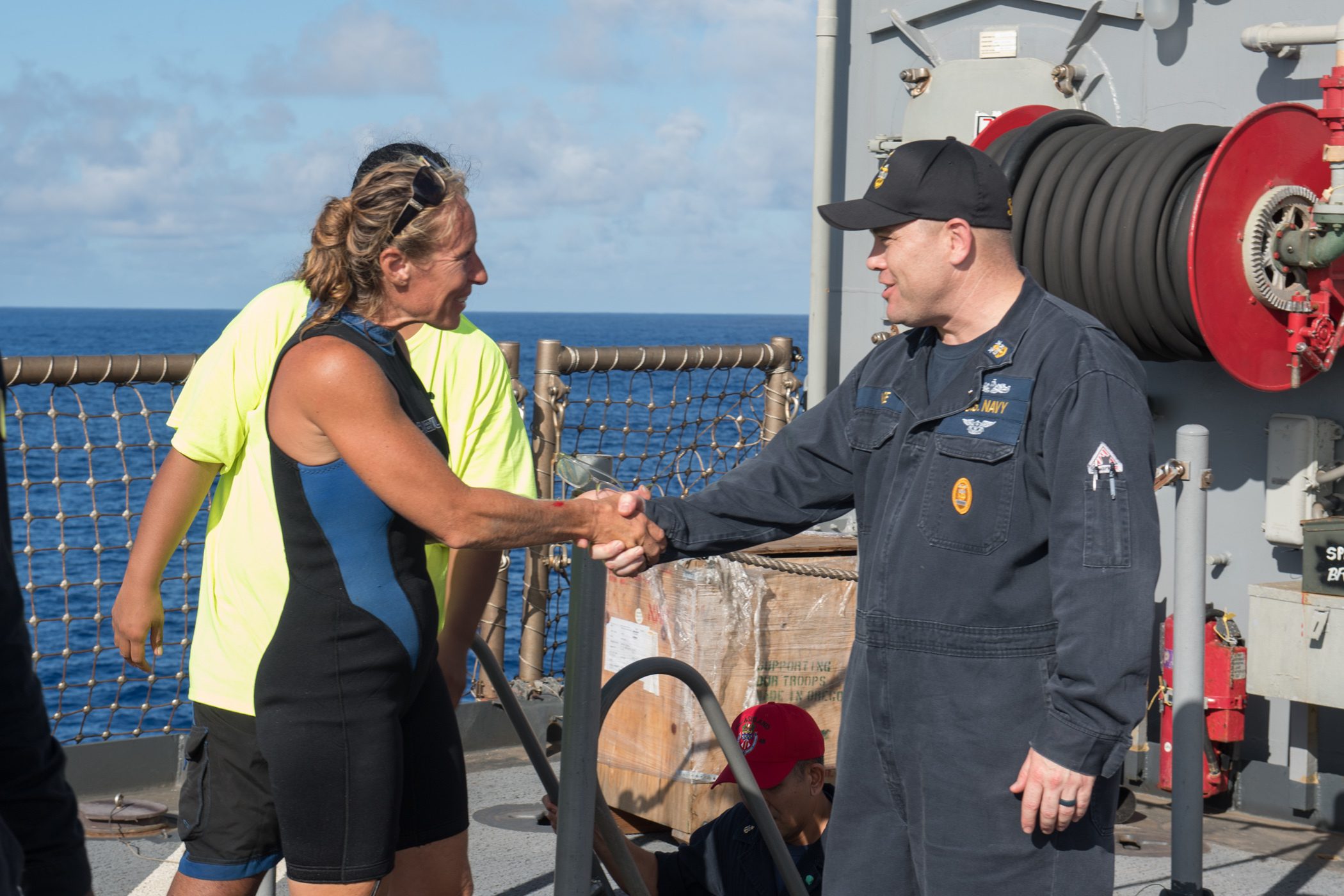
Two American Women Under Microscope And Defending Death Defying Nearly Six-Month Sailing Ordeal They Were Saved From By The Navy Last Month
by Heather Cassell
Experts have been seriously questioning two women’s story of being lost in the South Pacific following the Navy’s harrowing rescue last month as they started pulling apart, examining and finding fallacies in their story.
Under closer scrutiny, their tale at sea immediately started to fall apart and sound more like a tall tale of being lost at sea. The women are defending their version of what happened on the high seas.
The USS Ashland, a Navy ship based in Japan, rescued Jennifer Appel and Tasha Fuiava along with their two dogs, Valentine and Zeus, October 25, after the women flagged down a Taiwanese fishing boat and sent a rescue signal. Their story about drifting out at sea for nearly six months made headlines around the world.
However, after their dramatic rescue, red flags were raised by some of their statements about the storms, the sharks, islands they claimed they couldn’t dock in, the float plan filed or not filed, the mother’s call to the United States Coast Guard, the Taiwanese fisherman, the women claiming that they felt like they wouldn’t survive another 24-hours when they were rescued, but said they didn’t feel like they were in danger despite signaling for help for 98 days, and the failed communication devices.
Multiple agencies and experts started fact-checking and speaking out starting with the communication devices, the storms, and the two shark attacks the women said they encountered.
Stormy Sailing?
NASA satellite images never picked up on hurricane-like weather for three days the women said they encountered the night they sailed off from Honolulu aboard the Sea Nymph May 3. The National Weather Service also didn’t send out any storm notices because there weren’t any storms, Honolulu-based meteorologists Norman Hui and Charlie Woodrum told the media. The type of storm the women described would have triggered warning alerts and advisories in the Hawaiian Islands. Alerts were never issued because the waters around Hawaii were calm on the day they sailed into the Pacific toward Tahiti for their typical 18-day trip and the days surrounding their departure date, according to images from space.
The nearest storm was a tropical cyclone near Fiji, thousands of miles west of Hawaii.
The United States Coast Guard, Navy, and seasoned sailors continued to check on the women’s story. They asked questions about the boat being too big for the harbors on one of the Hawaiian Islands’ 137 smaller islands and islets and Wake Island, a small US territory in the middle of the Pacific.
The problem, much larger vessels than their 50-foot boat come and go regularly from these islands’ ports, reported the Chicago Tribune.
“We actually managed to get a hold of someone. We let them know that we’d been drifting for five months and we needed assistance,” Jennifer told CNN. “And they responded.”
“They said if we could get to the entrance to the harbor, that they would help us,” she continued.
“But we were on the north side of the island, and the entrance to the harbor is on the south side of the island, and the swell and the wind were pushing (us) west,” she said.
CNN attempted to contact authorities on the Wake Island but has not received a response, the media outlet reported.


Jennifer also defended questions about her account about the women’s concerns about the Taiwanese fishermen. She told reporters that the fishermen damaged the Sea Nymph while towing it and they didn’t feel safe. They lost the friendly feelings and kindness of the men prompting them to send out a distress call over the fisherman’s radio.
“If we couldn’t get additional help, that boat would sink, and they would get … two girls to do whatever they wanted to,” Jennifer told the media.
Captain Chen of the fishing boat, the Fong Chung No. 66, told the Associated Press that they received the mayday radio call, but didn’t understand it. They saw someone waving a white object, about a nautical mile away, reported the Tribune.
Chen told the AP that the women asked to use the fisherman’s satellite phone and to tow them to Midway Island, a small island between North America and Asia in the Pacific. In the morning, the women requested to stop towing them and they called for a naval vessel, he said.
“We offered to get them on board the fishing boat and asked whether they needed water or food, but they refused,” the captain told the AP.
Once the Navy arrived, the fishermen left.
The problem is that the Coast Guard and the Navy found the women did file a sailing plan and the Emergency Position Indicating Radio Beacon was registered with the Coast Guard and working as far as she knew, Tara Molle, petty officer 2nd class of the Coast Guard told CNN.
“I can’t speculate as to why they wouldn’t have activated it,” said Tara.
The woman “stated they never felt like they were truly in distress, like in a 24-hour period they were going to die,” she said.
Jennifer said that they had food and a way to purify water, so they thought they could wait until they made it to a safe haven to repair the boat.


The women could have been saved much sooner if they had used the EPIRB. The Coast Guard would have located them and arrived within an hour to 45-minutes.
“Theoretically, there are some places across the globe where it could take an hour due to satellite positions. All maritime governments work to rescue people if they go off,” Chris Edmonston, president of the Boat U.S. Foundation, a boat safety advocacy group, told NBC News.
Location aside, Chris criticized the women stating that if he had lost his engine he would have set off the EPIRB. The fact that the women said they were firing flares and radioing for assistance warranted setting off the EPIRB. It would have made the rescue easier and much sooner than it was, he said.
Chris then reasoned, “If I was just drifting, and I could put up a sail, and I had electric power, and I had some idea where I was, I might keep sailing,” he told NBC News adding that everyone’s judgment at sea is different.
Jennifer responded to Chris’ criticism asking people, “please do not allow the spin of ignorance to cloud good judgment,” she said.
“It would be shameful to call on the USCG resources when not in imminent peril and allow someone else to perish because of it. Every sailor knows that. Land people do not,” she said.
She added that they weren’t aware of a bent antenna on their radio that limited the range of their calls for help.
“Had we known our calls were going nowhere — we would have used the EPIRB — but hindsight is 20/20,” Jennifer said.
Chris shot back stating that by not activating the EPIRB was a disservice. The women could have received help at a better location, many that would have been easier rather than where the Navy found them.
Linus Wilson, author of several sailing books, including “How to Sail Around the World Part-Time,” was harsher in his criticism.
“At first, I thought she was totally reckless for shipping out during a storm, and she didn’t wait for a weather window,” Linus told NBC News. “But she just made up the storm.”
Was Jennifer’s mother in on the hoax?
The Coast Guard did receive a call about the women from a male “family friend” before they were scheduled to arrive in Tahiti May 19, reported NBC News. That was the only call the agency received and it was several days before the women were scheduled to arrive in Tahiti, reported the AP.
Sharks! Oh My?
Shark experts immediately debunked the women’s story about the two different shark attacks, including one that lasted for six hours. They told the media that they’ve never heard of any type of shark attacking, especially tiger sharks, a boat as the women described, other than “Jaws.”
The experts also noted that tiger sharks never jump out of the water, do not make coordinated attacks, and only grow to about 17 feet in length, not 20 – 30 feet, as the women described.
“There’s not an iota of accuracy relative to our knowledge of the shark in any of that,” says George Burgess, the director emeritus of the Florida Program for Shark Research at the Florida Museum of Natural History, stating the story sounds like something a child made up.
When the New York Times asked George about any other types of sharks behaving as the women described he said, “The only one that fits that pattern was the star of the movie ‘Jaws.’”


Investigation?
Even with questions raised about the women’s story and an investigation to address the discrepancies, the Coast Guard might find their story checks out, retired US Coast Guard Captain Kyle McAvoy told NBC News.
“I think the Coast Guard out in Hawaii has the lead at looking into all of this. Their job will be to peel back each layer of onion skin as the investigation plays out,” Kyle said. “I think they’re just going to have to look into it, and maybe this story does check out with a few hiccups.”
Chris agreed, stating “the seas do funny things to people’s thought processes.”
The Coast Guard is continuing to review the case, but no criminal investigation was underway, reported the AP.
Book your next adventure with Girls That Roam Travel. Contact Heather Cassell at Girls That Roam Travel at 415-517-7239 or at
To contract an original article, purchase reprints or become a media partner, contact







